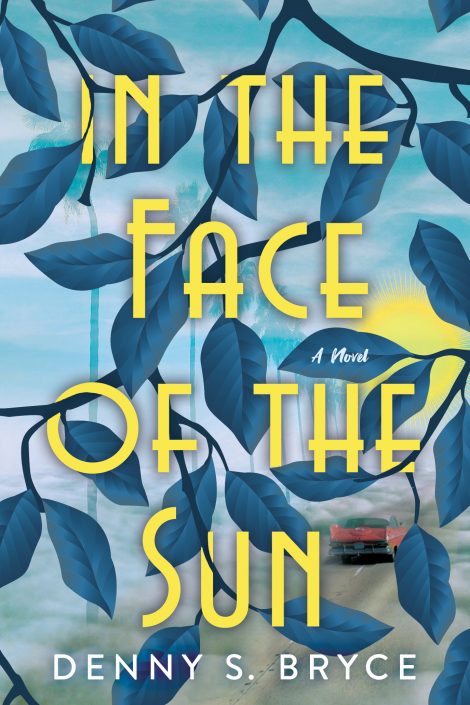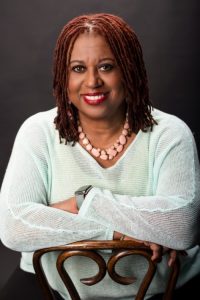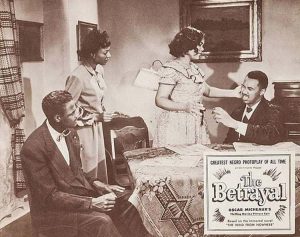
IN THE FACE OF THE SUN
At the height of the Civil Rights Movement amidst an America convulsed by the 1960s, a pregnant young woman and her brash, profane aunt embark upon an audacious road trip from Chicago to Los Angeles to confront a decades-old mystery from 1920’s Black Hollywood in this haunting novel of historical fiction from the author of Wild Women and the Blues.
A lime-gold Ford Mustang is parked outside my building. Unmistakable. My Aunt Daisy, the driver, is an audacious woman that no one in our family actually speaks to. They only speak about her—and not glowingly.
At the height of the Civil Rights Movement amidst an America convulsed by the 1960s, a pregnant young woman and her brash, profane aunt embark upon an audacious road trip from Chicago to Los Angeles to confront a decades-old mystery from 1920’s Black Hollywood in this haunting novel of historical fiction from the author of Wild Women and the Blues.
A lime-gold Ford Mustang is parked outside my building. Unmistakable. My Aunt Daisy, the driver, is an audacious woman that no one in our family actually speaks to. They only speak about her—and not glowingly. Still, she is part of my escape plan…
1928, Los Angeles: The newly-built Hotel Somerville is the hotspot for the city’s glittering African-American elite. It embodies prosperity and dreams of equality for all—especially Daisy Washington. An up-and-coming journalist, Daisy anonymously chronicles fierce activism and behind-the-scenes Hollywood scandals in order to save her family from poverty. But power in the City of Angels is also fueled by racism, greed, and betrayal. And even the most determined young woman can play too many secrets too far…
1968, Chicago: For Frankie Saunders, fleeing across America is her only escape from an abusive husband. But her rescuer is her reckless, profane Aunt Daisy, still reeling from her own shattered past. Frankie doesn’t want to know what her aunt is up to so long as Daisy can get her to LA—and safety. But Frankie finds there’s no hiding from long-held secrets—or her own surprising strength.
Daisy will do whatever it takes to settle old scores and resolve the past—no matter the damage. And Frankie will come up against hard choices in the face of unexpected passion. Both must come to grips with what they need, what they’ve left behind—and all that lies ahead…
- Kensington
- Paperback
- April 2022
- 320 Pages
- 9781496730107
About Denny S. Bryce
 Denny S. Bryce is the award-winning author of historical fiction novels including Wild Women and the Blues and In the Face of the Sun. A former professional dancer and public relations professional, she now is an adjunct professor in the MFA program at Drexel University, a book critic for NPR, and a freelance writer whose work has been published in USA Today, Harper’s Bazaar, and FROLIC Media. She is a member of the Historical Novel Society, Women’s Fiction Writers Association, and Tall Poppy Writers. Originally from Chicago, she now resides in Savannah, Georgia.
Denny S. Bryce is the award-winning author of historical fiction novels including Wild Women and the Blues and In the Face of the Sun. A former professional dancer and public relations professional, she now is an adjunct professor in the MFA program at Drexel University, a book critic for NPR, and a freelance writer whose work has been published in USA Today, Harper’s Bazaar, and FROLIC Media. She is a member of the Historical Novel Society, Women’s Fiction Writers Association, and Tall Poppy Writers. Originally from Chicago, she now resides in Savannah, Georgia.
Praise
“Bryce excels at placing readers in a glamorous time and place…riveting and vibrant.” – Booklist
Discussion Questions
1. Many have heard of some of the pioneers of Black Hollywood, actors such as Hattie McDaniel, Paul Robson, Butterfly McQueen and Dorothy Dandridge. What major obstacles do you think Black actors faced in the 1920s and 1930s? How do these challenges compare to what is happening in Hollywood today?
2. During the 1920’s and beyond, Black newspapers and magazines were a critical source of information, especially with regards to the events, actions, and people effecting the rights of the Black community. Are you familiar with any past or presently published Black newspapers? How do you think the significance and role of the Black press has changed since the 1920s?
3. Due to the draft, the Vietnam War had a personal impact on nearly every family and community throughout the 1960s. As young men were forced into military service by the hundreds of thousands, this impact was felt in varying ways throughout the country. Do you think the Vietnam War effected Black Americans differently from the rest of the country? If so, how?
4. The four main characters in this novel are women experiencing various stages of grief, discovery, love, and forgiveness. In what ways does the Hotel Somerville serve as a metaphor for these themes?
5. The Hotel Somerville eventually became the Dunbar Hotel, the cornerstone of the Los Angeles Jazz scene from the 1920s through the 1940s. What is the role of music in the novel’s 1928 storyline versus the 1968 storyline?
6. Several characters in this novel face various forms of abuse: physical, emotional, and racial, for example. How would you describe the long-term effects of abuse on an individual, male or female, versus its impact on a culture, gender, or ethnic group?
7. Sometimes referred to as “The Year that Changed America Forever,” 1968 was a year filled with significant events, turmoil, and tragedies. What events in 1968 do you think had the largest impact on the nation and the African American community in particular?
Excerpt
Prologue
Tuesday, June 12, 1990
Los Angeles
The night Veronica Fontaine died, there was a blackbird in the sky with a red and yellow triangle on its breast. It squawked like a crow. No song in its throat, just a curse, a string of damnations, blasting my eardrums.
I sit in the peacock wicker chair in the sunroom of the house on Naomi Street, holding a small cedar chest on my lap. The katydids’ song and the high-pitched chirping of crickets fill my heart with memories as the savory sweetness of night-blooming jasmine soothes my lonely soul.
Lifting my gaze, I look out the tall mullion windows as the sun slips beneath the horizon. How many hours have I spent in this chair staring through the glass, thinking through the years? Most of a lifetime? Perhaps.
A blackbird interrupts the stillness of the sunset. Slowly flapping its wings, flying across the blue and crimson sky, the lone bird seeks its flock, but their numbers have dwindled, and the once abundant bird no longer blankets the heavens.
If only I’d learned to love more deeply and less selfishly, I could’ve staved off the loss and the loneliness. But, like the bird, I never knew my great love story wasn’t a thing that would always be. Even at this stage of life, I sometimes believe I can fix the past with patience. As my mother used to say, a woman can accomplish many things, even in a world where she is outnumbered—if she knows when to leave and what direction to fly.
Moving my fingers over the polished surface of the cedar box, I linger on the metal latch.
I am alone except for the young girl, Maxine, who glares at me with a crossed expression on her brow. She is a constant of late, dropping by day in day out to ask about the past for an article she’s writing for the Los Angeles Times.
“What’s in the box?” Maxine says, she can be demanding.
“Letters, journals,” I answer. “And a newspaper article.”
“Can I read them?”
“Of course. It is why I searched every corner of this house to find them. They are my gift to you.”
“For my article about an old hotel?”
“The story is important to you, right?”
“Why wouldn’t it be?” Maxine replies. “I told you, I need the family angle. The personal tragedies will give the article a human face. Otherwise, it’s all about bricks and mortar. What’s the appeal in that?”
“I knew a man once who would say there was little more to life than bricks and mortar.” I study the girl’s eyes, wondering if she knows more than she lets on. “Be careful how you write about them, the building, the design, the heart of it. They are important things to some of us.”
“Things?” Maxine sighs. “I thought this was about people, family. Race and politics. Prejudice and hate.”
“Don’t get impatient with me. I’m your elder.”
“You’re not that old.”
“Eighty-two is not that old?” I chuckle. “If you insist, I will happily agree with you there.” I point to the box she now holds. “I’ve given you everything I have that will help you flesh out your story on the early days of the Hotel Somerville.”
“Do you mind if I read these here? I read fast, and we can talk about them this evening. Then, I can stay and help you finish packing.”
I look at Maxine suspiciously. “I’m not sure if that’s a good idea.”
“Why? You know you can trust me.”
“Okay, then. You can help me pack my bedroom. The rest of the house the movers will handle.”
“Outstanding.” The young girl glances around and points to the piano bench. “I’ll sit here.”
“Before you get comfortable, pour me a whiskey, darling.” I point at the small table in the corner with the silver tray and crystal brandy snifter.
“Yes, ma’am.” Maxine finishes making the drink.
I take a long sip, and the pungent liquid stings my nose and throat. “Do you want a drink? You’re welcome to have one. You’re old enough.”
“No thanks. I can’t do liquor.” Maxine sits on the bench and removes the newspaper clippings. “What is this?” She holds up a piece from the California Eagle.
“I can’t see what it says from here.” But I already know what is printed on the page. I could never forget the headlines, even if they are more than sixty years old.
“Who’s the Black man they arrested? For what? Going to a beach?”
“Keep reading,” I say.
A few minutes pass, and she looks up; her face is as ashen as a brown-skinned girl’s face can be.
“So Maxine, I think you understand now.”
She looks at me teary-eyed. “She was murdered. Who killed her?”
Questions I have heard and left unanswered a million times. But the truth was the murder wasn’t the deed of one person, and whether it happened in the hotel or on the corner of Hollywood and Vine didn’t matter.
“Finish reading,” I instruct Maxine. “Then, we can talk.”
Interviews
Q&A with Denny S. Bryce
Where did the idea for In the Face of the Sun come from?
I have had the opportunity to travel quite a bit between my various careers, and I adore hotels. One of my favorites is Culver Hotel in Los Angeles County. It opened in 1924 and has kept some of its original historical elements, with a piano bar, speakeasy, even a museum of sorts on its second level. The guest rooms also echo the past with high ceilings and a cozy, intimate feel. Still, the Culver Hotel did not permit African Americans to be guests in the 1920s, when my novel is set, so I set out to find a hotel that did. The Hotel Somerville was the first luxury hotel in Los Angeles for Blacks only. The Somerville was built by Dr. John Somerville, a prominent African American dentist (from Jamaica) in Los Angeles, in June 1928. That same month, the National Association for the Advancement of Colored People—NAACP—led by W.E.B Du Bois, held its annual meeting (the first on the west coast) at the hotel. Also, in 1928, the film Hallelujah was announced. It would be the first film from a major Hollywood studio (and directed by King Vidor) to be produced with an all-Negro cast. It opened in August of 1929. However, by 1990, the Somerville, which had been renamed the Dunbar Hotel decades earlier, was senior housing. This history got my “what if” juices flowing and became the geneses of In the Face of the Sun.
What are your approaches to writing novels?
I start with the era I intend to write in, and from there, I ‘create’ main characters if they are fictional, or I dig deep into their lives if I’m writing biographical fiction. After this, which takes some time, I look at the story arc and the key story questions. Somewhere in this process, I find the major themes my story will focus on. At this point, I can begin my outline.
How did you pursue writing?
I’ve always wanted to write stories. I wrote my first book in fourth grade—a Charlie’s Angels kind of who-dun-it with a bunch of my friends as crime fighters.
What are some of your most favorite recent reads? And an all-time favorite?
At the time of this writing, on my most recent read list, I must include Sisters in Arms by Kaia Alderson, Island Queen by Vanessa Riley, Our Woman in Moscow by Beatriz Williams, Seven Husbands Of Evelyn Hugo by Taylor Jenkins Reid, The Other Black Girl by Zakiya Dalila Harris. And that is the tip of the iceberg J of recent favorites. Now, as for an all-time favorite, I must go with one of my childhood reads – A Wrinkle in Time by Madeleine L’Engle.
What do you want people to know about your books?
My stories are designed to entertain and make the reader think, or that’s my goal and hope:). I also want to transport the reader to a time, place, and people they will become enthralled by.
What did you learn about yourself while writing this novel?
I have a lot of stories to tell. Seriously, the more research I dug into—the more story ideas popped into my head. Now, I want to learn to read faster; it wouldn’t hurt if I could write faster, too:)!
What is your favorite part of writing (drafting characters, making up scenes, plotting, developing emotional turning points, etc.)? Why?
I love revising. The first draft is to get the story on the page and find the rhythm of my main characters’ stories. In revision – that’s where the real writing comes into me – creating the flow, the nuances, nailing the theme, and fine-tuning those sentences, paragraphs, and scenes to keep the reader turning the pages. So, yes, revision is my happy place.
When do you do your best thinking about your work in progress?
Three o’clock in the morning:)! And it’s like clockwork. I can set my watch by it (and sometimes do:)!
Share something people may be surprised to know about you.
I feel like with all of the fabulous interviews I participated in during my virtual book tour for Wild Women and the Blues, what’s left to tell that people might not know? But of course, there is more to know. I’d say that I’m shy. I love talking about myself and my books and socializing. Still, I also am self-conscious and often anxious to get away from the crowds and take a moment (or twenty) for myself before returning to the playing field.
What’s the best piece of writing advice you’ve ever gotten?
Be patient. That’s a must, I believe, for writers seeking a professional career in publishing. Learn your craft, and don’t be discouraged. Keep writing, planning, and dreaming, and you will achieve the goals you’ve set for yourself.
Essay
What was Black Hollywood?
by Denny S. Bryce
Over the years, what defines Black Hollywood has changed, evolved, and in some cases impacted public opinion on issues that have divided our society, inspiring change.
IN THE FACE OF THE SUN is a character-driven novel (with a touch of mystery) written with a dual storyline and set in 1928 Los Angeles and during a 1968 road trip from Chicago to LA on Route 66. The main characters in the novel are fictional, but historical figures make an appearance, too, such as W. E. B. Du Bois, Jack Johnson, Drs. John and Vada Somerville, Stepin Fetchit, and more.
In the 1928 storyline of IN THE FACE OF THE SUN, the early days of Black Hollywood provide the backdrop for main character Daisy Washington, her sister Henrietta, an architect named Malcolm, a jazz guitarist named Isaiah, and a hotel – the majestic Hotel Somerville, the first luxury hotel in Los Angeles owned and built by Blacks exclusively for Black clientele. At the time, no other luxury hotel in Los Angeles allowed Negroes to register. They could work at the property as maids, butlers, and bellhops but couldn’t book a room for a night.
 During the 1920s—as the sign on the hillside read (until 1949)–Hollywoodland entered its boomtown phase. It was the home of one of the fastest-growing industries in America – filmmaking. By the late 1920s, talkies entered the game and accelerated the industry’s already rapid growth.
During the 1920s—as the sign on the hillside read (until 1949)–Hollywoodland entered its boomtown phase. It was the home of one of the fastest-growing industries in America – filmmaking. By the late 1920s, talkies entered the game and accelerated the industry’s already rapid growth.
But back to the question of what, who, or why Black Hollywood began. Here’s a passage from a website dedicated to Black Travel. It’s called Soul of America & A World of Black Travel (https://www.soulofamerica.com/).
Black Hollywood History started when movies started screening across America in 1896, shortly after the Supreme Court sanctioned racism in the Separate, But Equal ruling. Movies were the principal medium to communicate news, social customs, and visual entertainment to millions of Americans each week. Thus, more than schoolbooks and bibles, Hollywood movies shaped white folks’ perceptions of black folks.
In 1905, most African Americans portrayed in Hollywood films were white actors in blackface. To summarize, writer Gary Null in his book Black Hollywood, movie studios adopted a long-standing, minstrel stage practice of portraying black males as slow-talking, slew-footed, irresponsible dimwits, and lazy bucks…
I included historical figure Lincoln Perry, also known as Stepin Fetchit, in the novel’s 1928 timeline because this highly successful (but controversial) actor/comedienne was the highest paid contracted African American actors of his generation (during his early career). His acting (or comedy) style centered on the slow-talking, slew-footed, lazy Black male.
And the debate, even for some in the 1920s, was, is Stepin Fetchit a brilliant comedian or another Hollywood-created insult to African Americans?
I’d say the latter, but Stepin Fetchit was a trailblazer and embodied several firsts for an African American actor.
There are university courses on the subject of Black films in America, but if you are interested in learning more, I suggest you start by entertaining one of the world’s most popular pastimes: binge-watching. Here are some recommendations I believe you will find entertaining and educational.

By Right of Birth, 1921 – Presented by The Lincoln Motion Picture Company, considered to be the first all-Black movie production company in America. (https://www.youtube.com/watch?v=uCVrFj7fclg)
Body and Soul, 1925 – Produced, Written, and Directed by Oscar Micheaux (legendary Black filmmaker), staring Paul Robeson (https://www.youtube.com/watch?v=zUMti00K044)
Judge Priest, 1935 – Directed by John Ford, starring Will Rogers with Stepin Fetchit. (https://www.youtube.com/watch?v=Hhdkj0ZkIDQ)
Cabin in the Sky, 1943 – Directed by Vincente Minnelli (his directorial debut), starring Ethel Waters (https://www.youtube.com/watch?v=WhVsHMeE7Bg)
The Defiant Ones, 1958 – Directed by Stanley Kramer, starring Sidney Poitier and Tony Curtis (https://www.youtube.com/watch?v=fBrw8dmgarM)
A Raisin in the Sun, 1961 – Directed Daniel Petrie, starring Sidney Poitier, Ruby Dee, Claudia McNeil (https://www.youtube.com/watch?v=JMsnRzJdhew)
Sounder, 1972 – Directed by Martin Ritt, starring Cicely Tyson and Paul Winfield (https://www.youtube.com/watch?v=XPbP0g65ui8)
The Color Purple, 1985 – Directed by Steven Spielberg, starring Whoopi Goldberg, Danny Glover, Oprah Winfrey (https://www.youtube.com/watch?v=yFMCW5-jdqM)
Boyz N the Hood, 1991 – Directed by John Singleton, starring Ice Cube, Cuba Gooding, Jr., Lawrence Fishburne, Angela Bassett, and Morris Chestnut (https://www.youtube.com/watch?v=sLgCCdLbQNc)
Malcolm X, 1992 – Directed by Spike Lee, starring Denzel Washington and Spike Lee (https://www.youtube.com/watch?v=sx4sEvhYeVE)
